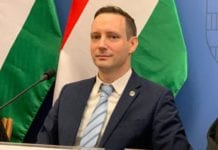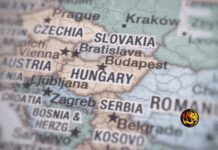Listen to this shorter version of the BosNewsLife News report via Vatican Radio:
By Stefan J. Bos, Chief International Correspondent BosNewsLife reporting from Bódvalenke, Hungary

BODVALENKE, HUNGARY (BosNewsLife)– A malnourished villager in northeastern Hungary, who claims to be 20-years-old, smiles while holding her premature baby in her arms. She likes a recently completed fresco showing Gypsy life and references to Jesus Christ. Nearby children are finishing the 33rd mural in Bódvalenke, the world’s only Fresco Village painted by Gypsy artists, also known as Roma.
Local women sing Christian and traditional songs as they welcome reporters visiting this heavily Roma village plastered with mural paintings.
The Roma briefly forget hardship in the forgotten corner of this European Union country, three-hours-drive from Budapest, where politicians decide their fate in a beautifully decorated luxurious parliament building.
Here, most residents have no running water or regular heating this winter. Roma stand in line near three wells after several others were closed because of austerity measures. Garbage collection has stopped; Women carry the garbage to a nearby field.
Budapest-based interpreter Eszter Pásztor wants to improve Roma fortunes as manager of the ‘Bódvalenke Fresco Village’ project, with support from Hungary’s Reformed Church and private donors.
Every week she races, Formula One-style, in a seven-year-old French car to this town of roughly 200 deeply impoverished residents.
HEART BREAKS
“My heart breaks when I see this hardship in Hungary,” the 60-year-old mother of two tells BosNewsLife, standing in front of a fresco on an autumn afternoon. “Through what we call the ‘Fresco Village’ we want to help end poverty and prejudices” that contributed to the killings of Hungarian Roma by Neo-Nazis in recent years, she explains.
“People live here on less than $2 a day. We hope frescos can turn this village into a touristic destination that could bring more income and hope to the local population.”

Additionally, Pásztor has private reasons to visit Bódvalenke. “I want to learn happiness. Amid this misery, Roma remain so happy while non-Roma Hungarians are very pessimistic,” she notes.
An enthusiastic Roma child triggered her one winter day to launch the fresco initiative. “I brought a group of Roma children to the Africa House in Budapest when suddenly a child looked at huts and said: ‘that’s how we live!’,” Pásztor recalls.
“Those words reminded me to a settlement I saw in the desert of Egypt where primitive mural paintings are shown to tourists. Suddenly I thought: ‘What if we could have more sophisticated frescos made by Roma artists?’.”
ROMA PAINTERS
Her Christmas season idea in 2008 eventually prompted Roma painters from Hungary and other European countries to brighten-up Bódvalenke homes. “This was something new for the villagers and we had to teach them art,” Pásztor explains.
“That’s why these paintings tell stories. About the village, about Roma history. There are often references to Christ. Roma are very religious, faith is important to them. A painter said: ‘Roma have a very special, direct and intimate relationship to God, and it shows on their paintings as well’.”
Seventeen Roma artists and two student groups painted the 33 murals, some wedged between Reformed and Catholic churches. Art historians say several paintings are “absolutely world standard” that any museum would happily exhibit.
“Bódvalenke is important because through it Roma art, invisible through centuries, has become and is becoming visible to the world,” adds Zoran Tairovic, a famed Serbian Roma painter and film director.
His name is linked to five remarkable paintings in Bódvalenke such as ‘The Metamorphoses of Horsepower’, featuring horse-like-creatures turning into a 21th century racing machine.
FUNDING TROUBLES
“To be honest, we were hoping to use this painting to get some funding for the Bódvalenke Fresco Village project from the the annual Formula One races in Hungary. Organizers liked it, but no money has arrived so far,” complaints the chain-smoking Pásztor.

Despite the center-right government’s “Roma Strategy” pledges, authorities refuse to finance the frescos or related jobs-creating activities through the ‘Fresco Village Social Cooperative’.
“An example of the prejudice-ridden environment was the refusal of our application for funding a small animal breeding project under the Goverment’s StartWork program, saying that ‘the Gypsies would just eat the animals anyway’,” Pásztor claims.
The government has denied wrongdoing and even Bódvalenke’s non-Roma mayor has his doubts. “These frescos don’t change anything,” says János Tóth, 33, who combines his mayoral duties with being a small farmer, ambulance driver and nurse.
“We see very few tourists and the additional projects are only for a few months.”
HIGH-LEVEL DELEGATION
The mayor didn’t even bother to welcome a high-level delegation that included European Commissioner László Andor and other government officials arriving at the village on International Romani Day, earlier this year. “Why would I?”, Tóth wonders after briefly interrupting feeding his noisy chickens.
“Look Eszter is employing very few people. A small tailoring plant launched in 2012, for instance, lasted only a few months.”
The mayor would prefer re-opening the communist-era cooperatives where everyone was employed. That’s not likely to happen. Lands around the village are said to be in the hands of two former communists-turned-big-farmers and Budapest speculators.
Pásztor admits the tailoring plant closed after just five months of operation. “It successfully delivered the first order, protective clothing for welders, which had to comply with three European standards. Unfortunately the other promised orders didn’t materialize.”
Other programs linked to her Fresco Village project are more successful, ranging from an annual Dragon Festival involving Roma musicians and poets performing in front of the frecos, to the Bódvalenke Women’s Choir who recently produced their first CD and sang in the European Parliament.
WOOD COLLECTION
Pásztor also supervised the re-establishment of a fishing pond and supported locals to improve gardens and produce cord dolls, wicker baskets or embroidery for visiting tourists.
Eleven Roma men were hired for waste wood collection. “We turn this into bio-briquette which we than sell as an energy source for power stations,” explains János Csonka, who leads Hungarian green energy company Innova-Eco Kft.
And nearly 20 Roma have been moved from ruinous hovels into somewhat better housing with bathrooms, though most of them without running water.

These families are the happy few within Hungary’s troubled Roma minority, comprising roughly 800,000 people on a 10-million population. Since the collapse of communism in 1989, most Roma lost their jobs.
The Fresco Village project has been adopted by the Hungarian Reformed Church Aid Foundation. “The church has to be where people are in need,” believes Foundation President Sándor Pál. “This isn’t a project for just some weeks. Maybe these frescos and related activities will help people to have a better future.”
FISH AND FAITH
His church, Hungary’s main Protestant denomination, also provides humanitarian aid. Yet, “It’s important that we bring not only fish, but also show them how to fish with education,” Pál cautions.
The Hungarian Reformed Church has been involved in a college for Roma. In Bódvalenke children are supported too. In 2009 some 23 of primary school children failed to finish their studies. Last year only one in 35 children failed to reach the education finish line, according to organizers.
Spiritual support is also crucial, claims Pál. “We hope the Roma will not only receive food and other aid but also the love of God. They need Christ in their lives. Our pastor is here to help them.”
Pál wants “the Fresco Village” to help overcome ill-feelings towards Roma even within the churches.
STILL STRUGGLING
“All the churches have to open their doors for Roma. We have to make bridges between Roma and non-Roma Hungarians, and Christians and non-Christians,” he says.
Yet locals say they still struggle with the daily burden of transition, including malnourished villager Henrietta Horváth.
“I am 20 years old and I just got Ádám, my second child,” she says while showing him to a BosNewsLife reporter.
He was born too early but survived, she says. “Life isn’t easy, but the mural painting in my garden makes me smile.”
At least for a moment.
(BosNewsLife, the first truly independent news agency covering persecuted Christians, is ‘Breaking the News for Compassionate Professionals’ since 2004).
Help BosNewsLife to be the voice of the voiceless. Click here for a subscription.
Follow BosNewsLife via Twitter









“The Roma briefly forget hardship in the forgotten corner of this European Union country, three-hours-drive from Budapest, where politicians decide their fate in a beautifully decorated luxurious parliament building.”
Because the fate of people from areas like the Detroit metropolitan region are represented on the national level in the Capitol. Is the Capitol a disgusting, dirty place?
Dear Okay,
Perhaps the Capitol is also a beautiful, decorated building, just as Hungary’s Parliament building. I am not American, was in Washington only once, but not in the Capitol complex. Whether it’s a “disgusting” place, I leave up to the voters.
Stefan J. Bos, BosNewsLife